(Source: Wikipedia)
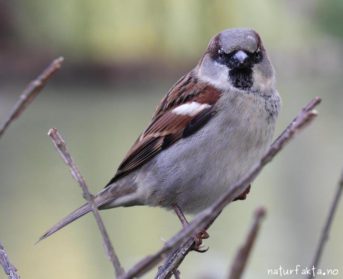
The House Sparrow (Passer domesticus) is a bird of the sparrow family Passeridae, found in most parts of the world. A small bird, it has a typical length of 16 cm and a mass of 24–39.5 g. Females and young birds are coloured pale brown and grey, and males have brighter black, white, and brown markings. One of about 25 species in the genus Passer, the house sparrow is native to most of Europe, the Mediterranean region, and much of Asia. Its intentional or accidental introductions to many regions, including parts of Australia, Africa, and the Americas, make it the most widely distributed wild bird.
The house sparrow is strongly associated with human habitations, and can live in urban or rural settings. Though found in widely varied habitats and climates, it typically avoids extensive woodlands, grasslands, and deserts away from human development. It feeds mostly on the seeds of grains and weeds, but it is an opportunistic eater and commonly eats insects and many other foods. Its predators include domestic cats, hawks, owls, and many other predatory birds and mammals.

The Collared Dove is a wood pigeon, similar in length to a rock pigeon but slimmer and longer-tailed, and slightly larger than the related turtle dove, with an average length of 32 cm from tip of beak to tip of tail, with a wingspan of 47–55 cm and a weight of 125–240 g. It is grey-buff to pinkish-grey overall, a little darker above than below, with a blue-grey under wing patch. The tail feathers are grey-buff above, and dark grey tipped white below; the outer tail feathers also tipped whitish above. It has a black half-collar edged with white on its nape from which it gets its name. The short legs are red and the bill is black. The iris is red, but from a distance the eyes appear to be black, as the pupil is relatively large and only a narrow rim of reddish-brown iris can be seen around the black pupil. The eye is surrounded by a small area of bare skin, which is either white or yellow. The two sexes are virtually indistinguishable; juveniles differ in having a poorly developed collar, and a brown iris.

The Blackbird (Turdus merula) is a species of thrush. It breeds in Europe, Asia, and North Africa, and has been introduced to Canada, United States, Mexico, Peru, Brazil, Argentina, Uruguay, the Falkland Islands, Chile, South Africa, Australia and New Zealand. It has a number of subspecies across its large range; a few of the Asian subspecies are sometimes considered to be full species. Depending on latitude, the common blackbird may be resident, partially migratory, or fully migratory.
The male of the nominate subspecies, which is found throughout most of Europe, is all black except for a yellow eye-ring and bill and has a rich, melodious song; the adult female and juvenile have mainly dark brown plumage. This species breeds in woods and gardens, building a neat, mud-lined, cup-shaped nest. It is omnivorous, eating a wide range of insects, earthworms, berries, and fruits Both sexes are territorial on the breeding grounds, with distinctive threat displays, but are more gregarious during migration and in wintering areas. Pairs stay in their territory throughout the year where the climate is sufficiently temperate.
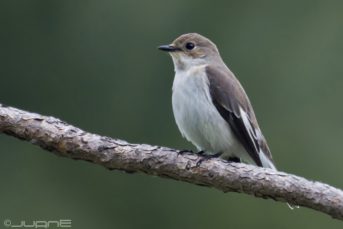
The European pied flycatcher (Ficedula hypoleuca) is a small passerine bird in the Old World flycatcher family. One of the four species of Western Palearctic black-and-white flycatchers, it hybridizes to a limited extent with the collared flycatcher. It breeds in most of Europe and western Asia. It is migratory, wintering mainly in western Africa.It usually builds its nests in holes on oak trees.This species practices polygyny, usually bigamy, with the male travelling large distances to acquire a second mate. The male will mate with the secondary female and then return to the primary female in order to help with aspects of child rearing, such as feeding. The European pied flycatcher is mainly insectivorous, although its diet also includes other arthropods. This species commonly feeds on spiders, ants, bees and similar prey. The European pied flycatcher has a very large range and population size and so it is of least concern according to the International Union for Conservation of Nature (IUCN).
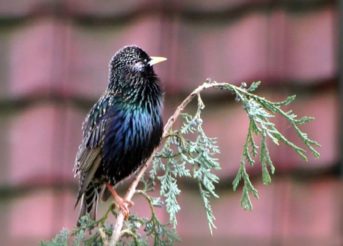
Starlings are small to medium-sized passerine birds in the family Sturnidae. Starlings are native to Europe, Asia and Africa, as well as northern Australia and the islands of the tropical Pacific. Several European and Asian species have been introduced to these areas as well as North America, Hawaii and New Zealand, where they generally compete for habitats with native birds and are considered to be invasive species. The starling species familiar to most people in Europe and North America is the common starling. Starlings have strong feet, their flight is strong and direct, and they are very gregarious. Their preferred habitat is fairly open country, and they eat insects and fruit. Several species live around human habitation and are effectively omnivores. Plumage of many species is typically dark with a metallic sheen. They nest in holes and lay blue or white eggs. Starlings have diverse and complex vocalizations and have been known to embed sounds from their surroundings into their own calls, including car alarms and human speech patterns. The birds can recognize particular individuals by their calls and are currently the subject of research into the evolution of human language.

The Stock Dove in the genus Columba is the largest within the pigeon family, and has the widest distribution. Its members are typically pale grey or brown, often with white head or neck markings or iridescent green or purple patches on the neck and breast. The neck feathers may be stiffened and aligned to form grooves, but these are absent in this species. The stock dove is less grey in plumage than other pigeons in Europe.
The stock dove is sociable as well as gregarious, often consorting with wood pigeons, though doubtless it is the presence of food which brings them together.
The short, deep, «grunting» Ooo-uu-ooh call is quite distinct from the modulated cooing notes of the wood pigeon; it is loud enough to be described, somewhat fancifully, as «roaring».

The European robin (Erithacus rubecula), known simply as the robin or robin redbreast in the British Isles and Ireland is a small insectivorous passerine bird, specifically a chat, that was formerly classed as a member of the thrush family (Turdidae), but is now considered to be an Old World flycatcher. Around 12.5–14.0 cm in length, the male and female are similar in colouration, with an orange breast and face lined with grey, brown upperparts and a whitish belly. It is found across Europe, east to Western Siberia and south to North Africa; it is sedentary in most of its range except the far north.
The term robin is also applied to some birds in other families with red or orange breasts. These include the American robin(Turdus migratorius), which is a thrush, and the Australasian robins of the family Petroicidae, the relationships of which are unclear.

The wagtails form the passerine bird genus Motacilla. The common name and genus names are derived from their characteristic tail pumping behaviour.
Wagtails are slender, often colourful, ground-feeding insectivores of open country in the Old World. Species of wagtail breed in Africa, Europe and Asia, some of which are fully or partially migratory. Two species also breed in Alaska, and wintering birds may reach Australia.
They are ground nesters, laying up to six speckled eggs at a time.Among their most conspicuous behaviours is a near constant tail wagging, a trait that has given the birds their common name. In spite of the ubiquity of the behaviour and observations of it, the reasons for it are poorly understood. It has been suggested that it may flush up prey, or that it may signal submissiveness to other wagtails. Recent studies have suggested instead that it is a signal of vigilance that may aid to deter potential predators.

The carrion crow was one of the many species originally described by Linnaeus in his 18th century work Systema Naturae and it still bears its original name of Corvus corone.The binomial name is derived from the Latin Corvus, «Raven», and Greek korone«crow».
The plumage of carrion crow is black with a green or purple sheen, much greener than the gloss of the rook. The bill, legs and feet are also black. It can be distinguished from the common raven by its size (48–52 cm in length as compared to an average of 63 centimetres for ravens) and from the hooded crow by its black plumage, but there is frequent confusion between it and the rook. It has a wingspan of 84–100 cm. The beak of the crow is stouter and in consequence looks shorter, and whereas in the adult rook the nostrils are bare, those of the crow are covered at all ages with bristle-like feathers.

The great tit (Parus major) is a passerine bird in the tit family Paridae. It is a widespread and common species throughout Europe, the Middle East, Central and Northern Asia, and parts of North Africa where it is generally resident in any sort of woodland; most great tits do not migrate except in extremely harsh winters. The great tit remains the most widespread species in the genus Parus. The great tit is predominantly insectivorous in the summer, but will consume a wider range of food items in the winter months, including small hibernating bats. Like all tits it is a cavity nester, usually nesting in a hole in a tree. The nests may be raided by woodpeckers, squirrels and weasels and infested with fleas, and adults may be hunted by sparrowhawks. The great tit has adapted well to human changes in the environment and is a common and familiar bird in urban parks and gardens. The great tit is also an important study species in ornithology.
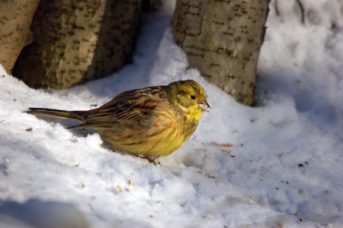
The yellowhammer (Emberiza citrinella) is a passerine bird in the bunting family, native to Eurasia. Most European birds remain in the breeding range year-round, but the eastern subspecies is partially migratory, with much of the population wintering further south. The male yellowhammer has a bright yellow head, streaked brown back, chestnut rump and yellow underparts. Other plumages are duller versions of the same pattern. The yellowhammer is common in open areas with some scrubs or trees, and forms small flocks in winter. It has a characteristic song with an «A little bit of bread and no cheese» rhythm.
Breeding commences mainly in April and May, with the female building a lined cup nest in a concealed location on or near the ground. The 3–5 eggs are patterned with a mesh of fine dark lines, giving rise to the old name for the bird of «scribble lark». The female incubates the eggs for 12–14 days to hatching, and broods the altricial downy chicks until they fledge 11–13 days later.

The Eurasian siskin (Spinus spinus) is a small passerine bird in the finch family Fringillidae. It is very common throughout Europe and Asia. It is found in forested areas, both coniferous and mixed woodland where it feeds on seeds of all kinds, especially of alder and conifers.
It can be distinguished from other similar finches by the color of the plumage. The upper parts are greyish green and the under parts grey-streaked white. Its wings are black with a conspicuous yellow wing bar, and the tail is black with yellow sides. The male has a mainly yellow face and breast, with a neat black cap. Female and young birds have a greyish green head and no cap. It is a trusting, sociable and active bird. The song of this bird is a pleasant mix of twitters and trills. For these reasons it is often raised in captivity.
These birds have an unusual migration pattern as every few years in winter they migrate southwards in large numbers. The reasons for this behaviour are not known but may be related to climatic factors and above all the availability of food. In this way overwintering populations can thrive where food is abundant. This small finch is an acrobatic feeder, often hanging upside-down like a tit. It will visit garden bird feeding stations.
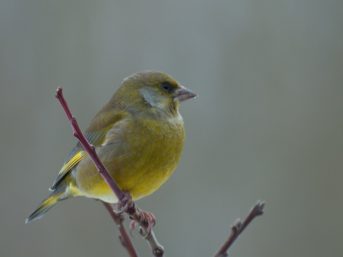
The European greenfinch, or just greenfinch (Chloris chloris) is a small passerine bird in the finch family Fringillidae.
This bird is widespread throughout Europe, north Africa and south west Asia. It is mainly resident, but some northernmost populations migrate further south. The greenfinch has also been introduced into both Australia and New Zealand. In Malta, it is considered a prestigious song bird, and it has been trapped for many years. It has been domesticated, and many Maltese people breed them.
The greenfinch is 15 cm (5.9 in) long with a wing span of 24.5 to 27.5 cm (9.6 to 10.8 in). It is similar in size and shape to a house sparrow, but is mainly green, with yellow in the wings and tail. The female and young birds are duller and have brown tones on the back. The bill is thick and conical. The song contains a lot of trilling twitters interspersed with wheezes, and the male has a «butterfly» display flight.
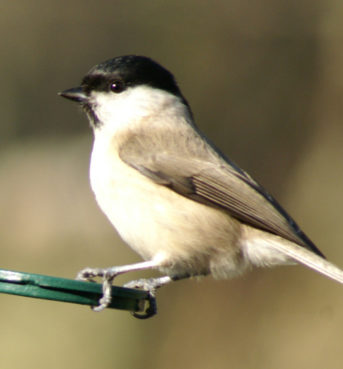
The willow tit (Poecile montanus) is a passerine bird in the tit family, Paridae. It is a widespread and common resident breeder throughout temperate and subarctic Europe and northern Asia. It is more of a conifer specialist than the closely related marsh tit, which explains it breeding much further north. It is resident, and most birds do not migrate.
The willow tit is distinguished from the marsh tit by a sooty brown instead of a glossy blue black cap; the general colour is otherwise similar, though the under parts are more buff and the flanks distinctly more rufous; the pale buff edgings to the secondaries form a light patch on the closed wing. The feathers of the crown and the black bib under the bill are longer, but this is not an easily noticed character. However, the more graduated tail (not square) shows distinctly when spread. Length is 11.5 cm, and wings range from 60–70 mm.
The willow tit often excavates its own nesting hole, even piercing hard bark; this is usually in a rotten stump or in a tree, more or less decayed. Most nests examined are cups of felted material, such as fur, hair and wood chips, but feathers are sometimes used. The number of eggs varies from six to nine, with reddish spots or blotches..
Birds feed on insects, caterpillars, and seeds, much like other tits. This species is parasitised by the moorhen flea.

The great spotted woodpecker (Dendrocopos major) is a bird of the woodpecker family. The genus name Dendrocopus is a combination of the Greek words dendron , meaning «tree» and kopos, «striking «. The specific major is from Latinmaior, «greater». It is distributed throughout Europe and northern Asia, and usually resident year-round except in the colder parts of its range. It is not considered a threatened species by the IUCN, being widely distributed and quite common. The great spotted woodpecker is 23–26 centimetres ( long, with a 38–44 centimetres wingspan. Weight: 70–98 g. The upperparts are glossy black, with white on the sides of the face and neck.
Males have a crimson spot on the nape, which is absent in females and juvenile birds. In the latter, the top of the head is crimson between the bill and the center of the crown instead.
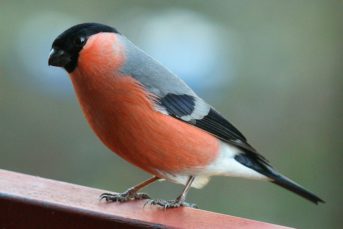
The bullfinch is a bulky bull-headed bird. The upper parts are grey; the flight feathers and short thick bill are black; as are the cap and face in adults (they are greyish-brown in juveniles), and the white rump and wing bars are striking in flight. The adult male has red underparts, but females and young birds have grey-buff underparts. The song of this unobtrusive bird contains fluted whistles.
This bird breeds across Europe and temperate Asia. It is mainly resident, but many northern birds migrate further south in the winter. Mixed woodland with some conifers is favoured for breeding, including parkland and gardens.
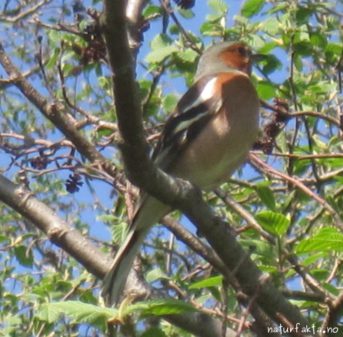
The common chaffinch (Fringilla coelebs), usually known simply as the chaffinch, is a common and widespread small passerine bird in the finch family. The male is brightly coloured with a blue-grey cap and rust-red underparts. The female is much duller in colouring but both sexes have two contrasting white wings-bars and white sides to the tail. The male bird has a strong voice and sings from exposed perches to attract a mate.
The chaffinch breeds in much of Europe, across Asia to Siberia and in northwest Africa. It prefers open woodland and often forages on the ground. The female builds a nest with a deep cup in the fork of a tree. The clutch is typically 4–5 eggs, which hatch in about 13 days. The chicks fledge in around 14 days but are fed by both adults for several weeks after leaving the nest. The chaffinch is a partial migrant; birds breeding in warmer regions are sedentary while those breeding in the colder northern areas of its range winter further south.

The brambling is similar in size and shape to a common chaffinch. Breeding-plumaged male bramblings are very distinctive, with a black head, dark upperparts, orange breast and white belly. Females and younger birds are less distinct, and more similar in appearance to some chaffinches. In all plumages, however, bramblings differs from chaffinches in a number of features. The brambling has a white rump whereas that of chaffinch is grey-green, the breast is orange, contrasting with a white belly on brambling, whereas on chaffinch the underparts of more uniformly coloured (pink or buff);
The brambling’s scapular feathers are orange, whereas chaffinch’s are grey or grey-brown and the flanks are dark-spotted on brambling, plain on chaffinch and the bramblings lack the white outer tail feathers of chaffinch.
An additional difference for all plumages except breeding-plumaged males is the bill colour – yellow in brambling, dull pinkish in chaffinch (breeding-plumaged male bramblings have black bills, chaffinches in the corresponding plumage have grey bills).

The Eurasian blue Tit is usually 12 cm long with a wingspan of 18 cm for all genders, and weighs about 11 g . A typical Eurasian blue tit has an azure blue crown and dark blue line passing through the eye, and encircling the white cheeks to the chin, giving the bird a very distinctive appearance. The forehead and a bar on the wing are white. The nape, wings and tail are blue and the back is yellowish green. The underparts is mostly sulphur-yellow with a dark line down the abdomen—the yellowness is indicative of the number of yellowy-green caterpillars eaten, due to high levels of carotene pigments in the diet. The bill is black, the legs bluish grey, and the irides dark brown. The sexes are similar, but under ultraviolet light, males have a brighter blue crown. Young blue tits are noticeably more yellow.
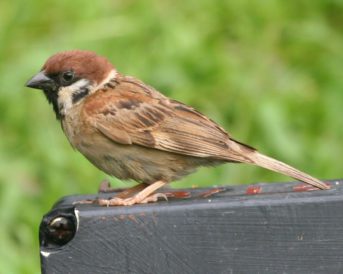
by Lip Kee via Flickr, Creative Commons Attribution ShareAlike.
The Eurasian tree Sparrow is 12.5–14 cm long, with a wingspan of about 21 cm and a weight of 24 g making it roughly 10% smaller than the house sparrow.The adult’s crown and nape are rich chestnut, and there is a kidney-shaped black ear patch on each pure white cheek; the chin, throat, and the area between the bill and throat are black. The upperparts are light brown, streaked with black, and the brown wings have two distinct narrow white bars. The legs are pale brown, and the bill is lead-blue in summer, becoming almost black in winter.
This sparrow is distinctive even within its genus in that it has no plumage differences between the sexes; the juvenile also resembles the adult, although the colours tend to be duller. Its contrasting face pattern makes this species easily identifiable in all plumages; the smaller size and brown, not grey, crown are additional differences from the male house sparrow. Adult and juvenile Eurasian tree sparrows undergo a slow complete moult in the autumn, and show an increase in body mass despite a reduction in stored fat. The change in mass is due to an increase in blood volume to support active feather growth, and a generally higher water content in the body.
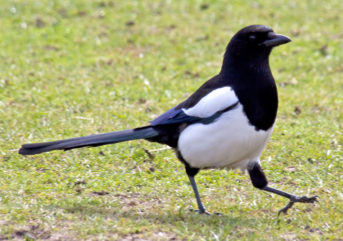
Magpies are birds of the Corvidae (crow) family, including the black and white Eurasian magpie, which is considered one of the most intelligent animals in the world, and the only non-mammal species able to recognize itself in a mirror test (though a recent study suggests that giant manta rays can also recognize their own reflection). In addition to other members of the genus Pica, corvids considered as magpies are in the genera Cissa.









